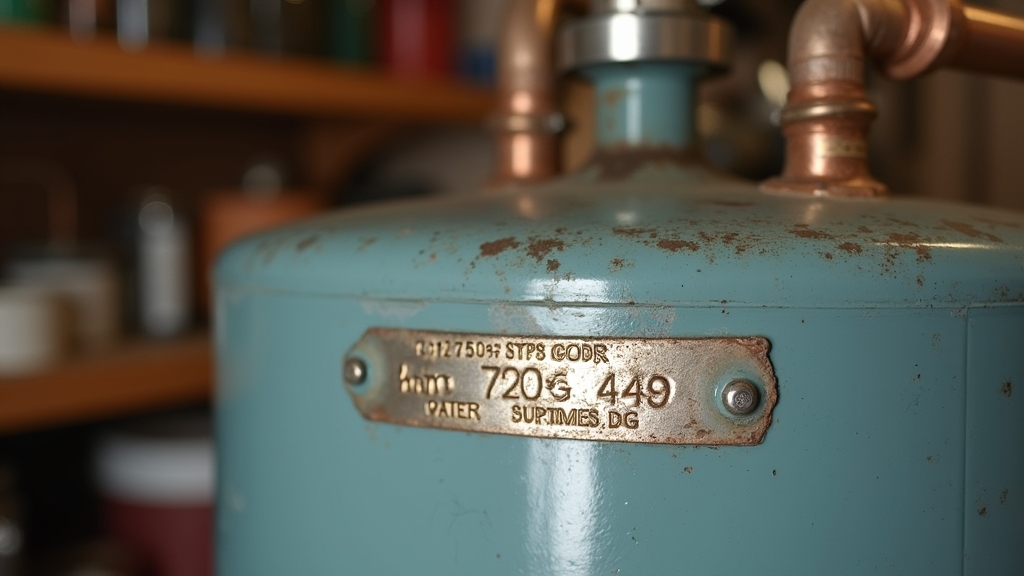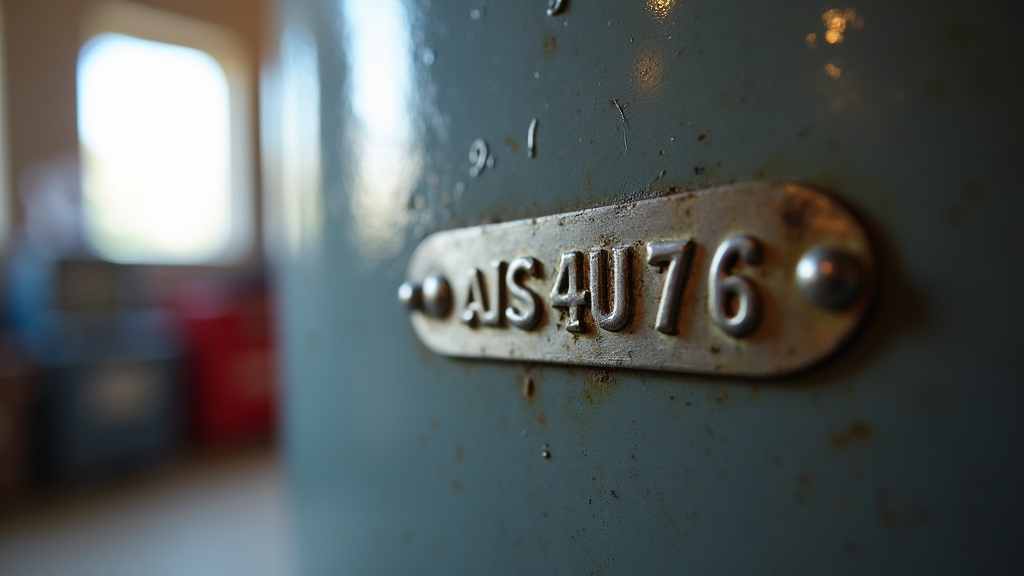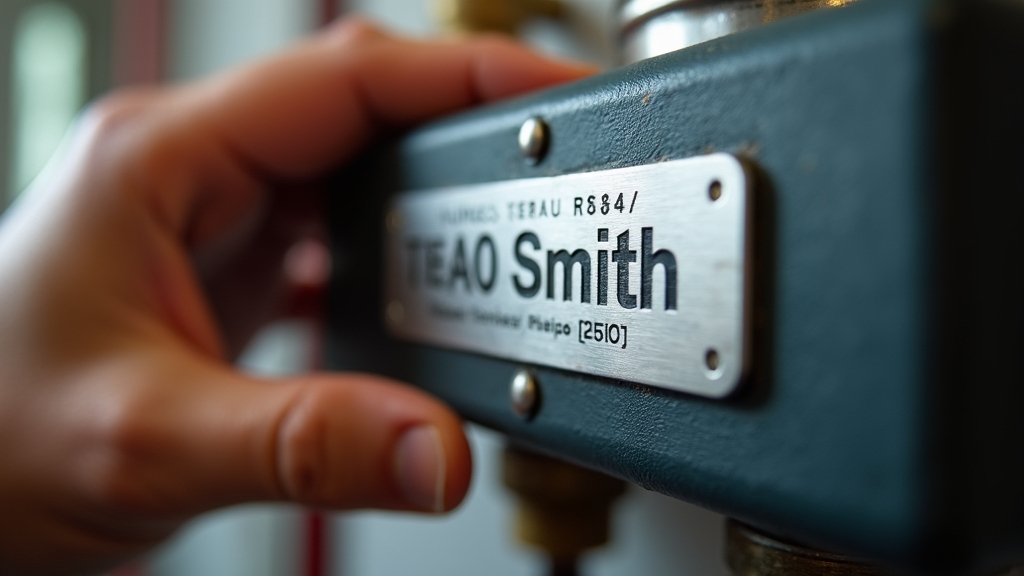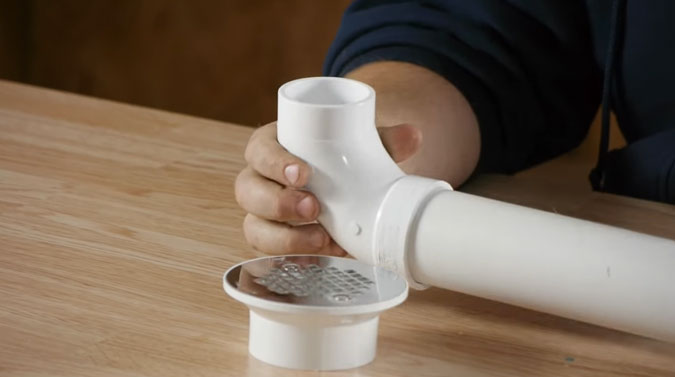You can determine the age of your AO Smith water heater by decoding its serial number, located on the rating plate near the top or side of the tank. For units made before 2008, the serial often includes a two-digit year and week code or letter-month-year format.
Post-2008 units typically show a four-digit year and two-digit month. Comparing this with the installation date confirms the exact age. Understanding this helps with maintenance and safety planning. More details reveal the decoding specifics and why age matters.
Key Takeaways
- Locate the serial number on the rating data plate attached to the water heater’s exterior, usually near the top or side of the tank.
- Decode the serial number: pre-2008 units use letter-month and two-digit year codes; post-2008 units display a four-digit year and two-digit month.
- For pre-2008 models, interpret the first two digits as the year and the next two as the week of manufacture.
- Cross-check the serial number’s manufacture date with installation documents or tags to confirm the unit’s actual age.
- Knowing the age helps schedule maintenance, assess eligibility, and anticipate efficiency or safety issues due to wear and corrosion.
Understanding Serial Number Formats for AO Smith Water Heaters

When you need to determine the age of an AO Smith water heater, understanding the serial number format is essential because it encodes the manufacturing date.
Pre-2008 American Water Heater Company units use a 10-digit serial number where the first two digits represent the year, and the next two indicate the week of manufacture. For example, “0602” means the 2nd week of 2006.
AO Smith’s pre-2008 serial numbers for Glascote and Perma-Glas brands use a letter-month code (A to M, excluding I) followed by a two-digit year, like “H06” for August 2006. Proper understanding of manufacturing dates helps ensure effective maintenance scheduling.
Post-2008 serial numbers show a four-digit year and a two-digit month on the rating plate, enabling precise age identification. Note that the serial number coding for AO Smith water heaters remained consistent after their acquisition of State Industries in 2008, which helps simplify decoding.
Decoding Style 1A and 1B Serial Numbers
For Style 1a, the first four digits represent the year and week of manufacture. The first two digits show the year (e.g., “12” for 2012), followed by two digits for the week (e.g., “10” for the 10th week). Letters immediately follow these digits, serving as factory codes but not affecting the date.
Understanding the serial number decoding is similar to familiarizing with pump components before disassembly to ensure accurate interpretation. In Style 1b, the serial starts with a letter, then four digits indicating year and week. Digits two and three are for the year, and digits four and five are for the week, separated by a space from other data.
Recognizing these patterns lets you pinpoint the exact production week, which is essential for checks and service planning. Knowing the manufacturer’s date is crucial because regular repair and servicing can significantly extend the water heater’s durability and efficiency.
Interpreting Style 1C Serial Number Patterns

Why does the Style 1c serial number stand out among AO Smith water heater codes? Because its first two digits directly indicate the manufacture year, unlike styles 1a and 1b. For example, “18” means 2018.
The next two digits specify the week of manufacture (01–53), allowing you to pinpoint production to a specific week. This precise dating method helps in assessing maintenance needs and coverage based on manufacture date accuracy.
This style appears on older units from A.O. Smith and State Industries, mainly from the 1970s through early 2000s. By decoding these four digits, you can accurately estimate the heater’s age, assess status, and decide on repairs or replacement.
Understanding the serial number format is crucial since older serial numbers often reflect vintage production standards. Be aware that some early serials may have inconsistencies, so cross-reference with brand history when in doubt. This method is essential for servicing legacy water heaters.
Identifying Manufacture Year From Styles 2, 3, and 4
Although AO Smith employs several serial number styles, Styles 2, 3, and 4 share a common feature: the first two digits indicate the manufacture year.
To identify the year, locate these digits at the start of the serial number—for example, “04” denotes 2004 in Style 2’s “AF04A093001” or “03” for 2003 in Style 3’s “CG03-1495366-S29.” Style 4 also uses this two-digit prefix for year identification, as in “E07A135491” representing 2007.
After pinpointing the year, check for a letter code representing the manufacture month, typically located immediately after the year digits. Letters A through M (excluding I) correspond to January through December, respectively. Knowing the exact age of your water heater is crucial as it helps anticipate replacement timing and ensures you can plan maintenance accordingly.
This precise decoding allows accurate determination of AO Smith water heater’s manufacturing date for maintenance or verification. Proper maintenance can be enhanced by understanding critical factors that affect system longevity and performance.
Reading Serial Numbers on Tankless AO Smith Models
When you examine the serial number on an AO Smith tankless water heater, you’ll notice the first two digits represent the manufacture year, followed by two digits indicating the production week.
For example, “2015” means the unit was made in the 15th week of 2020. This four-digit numeric format has been standard since about 2008, replacing older letter-based codes.
You’ll find the serial number on the metal rating plate, typically located on the unit’s side. Proper installation and maintenance directly impact the water heater’s longevity and performance, making it important to consider the installation quality.
If you encounter uncertainties, AO Smith customer support can assist with decoding. This streamlined serial number system simplifies age determination for all tankless models.
Locating Date Markings on AO Smith Water Heater Labels
Where exactly can you find the essential date markings on an AO Smith water heater? These critical details are located on the rating data plate label firmly attached to the tank’s exterior. You won’t need to disassemble anything to access it.
Typically, the label is positioned near the top or side of the water heater tank and is rectangular or square in shape, made from metal or durable plastic. It clearly displays the serial number and manufacturing information, including the model number, ANSI standard revision year, and sometimes installation dates.
Understanding potential issues like sediment buildup in water systems can also help in assessing the condition of your water heater. Knowing the age helps determine replacement timing, which is crucial since water heaters have a finite lifespan.
The serial number encodes the month and year of manufacture through letters and numbers. Locating this label lets you decode the manufacture date precisely, enabling accurate age determination of your AO Smith water heater.
Using Installation Date to Verify Water Heater Age
You can find the installation date on service orders, invoices, or property maintenance logs, providing a reliable reference for your water heater’s age. This date is essential for verifying operational lifespan and scheduling maintenance.
Always cross-check the installation date with the serial number to confirm accuracy and identify any discrepancies. For A.O. Smith water heaters, the serial number’s first digits indicate the year of manufacture, which helps verify the installation date.
Understanding the power requirements of your water heater can also aid in assessing its efficiency and compatibility with solar energy systems.
Location of Installation Date
Although the installation date isn’t always prominently displayed, you can often find it stamped or written directly on the product label or rating data plate attached to your AO Smith water heater. This date is vital for verifying the unit’s operational start.
Look for the installation date in these locations:
- On the product label or rating data plate near the serial and model numbers
- On a separate sticker or tag affixed close to the main labels
- Inside the access panel covering the thermostat or burner (gas models)
- On handwritten notes or stamps by installers on the unit’s label
- Within installation or service documentation provided at purchase, where you can also use the serial number to determine the exact production year and week. You can also assess the unit’s condition to understand its overall operational status and longevity by referencing pump capacity concepts.
Importance of Installation Date
Locating the installation date on your AO Smith water heater provides more than just a timestamp; it offers a key reference for verifying the unit’s true age. This date marks when the unit began operation, which may differ from the manufacture date on the serial number.
The serial number, found on the rating plate sticker, contains the manufacturing date encoded as the first two digits for the year and the next two digits for the week of production. Understanding the unit’s age can also help diagnose issues related to mineral scale buildup, a common problem in older water heaters.
By confirming the installation date, you can accurately assess the heater’s age and expected service life. Maintenance schedules such as flushing and anode rod replacement should be based on this date to optimize performance and prevent premature failure.
Additionally, documenting installation helps validate supports for liability processes. Tracking the installation date ensures you maintain an accurate timeline for service, repair, and replacement decisions, ultimately enhancing reliability and safety of your water heater system.
Cross-checking Serial Number
How can you confirm the true age of your AO Smith water heater beyond just reading its serial number? Cross-checking the serial number against the installation date provides a reliable verification method.
Start by locating the serial number on the rating plate and decoding it according to the production era—year and month for pre-2008 units, year and week for post-2008. Understanding the working accuracy of the decoding process ensures precise age determination.
Then compare this manufacture date to the installation date on the label. If the installation date is missing or unclear, you can use the serial number to determine the age of the unit since serial numbers can help determine the age.
Ensure the installation date logically follows the manufacture date. Any inconsistency may indicate errors or replacements. Key steps include:
- Locate serial number and installation date on the heater label
- Decode manufacture year and month/week from serial number
- Confirm installation date is after manufacture date
- Calculate approximate age by comparing dates to the current year
- Use discrepancies to assess potential label errors or unit replacement
Importance of Knowing the Water Heater’s Age for Maintenance
Knowing your water heater’s age lets you schedule maintenance before issues arise, reducing costly breakdowns and inefficiencies. As units age, they consume more energy and require more frequent inspections, impacting your operating costs.
Identifying the age also helps mitigate safety risks by ensuring timely replacement or repairs to prevent leaks and failures. To determine the age accurately, locating and decoding the serial number on the manufacturer’s label is essential.
Maintenance Scheduling Benefits
Because water heaters have a limited lifespan, typically 8 to 15 years for traditional units and up to 20 years for tankless models, scheduling maintenance based on the unit’s age is vital to guarantee reliable performance and longevity.
Knowing the water heater’s age lets you plan inspections and preventive care precisely, reducing risks of sudden failures and costly repairs. It also helps maintain validity by proving routine upkeep. Key maintenance benefits include:
- Targeted inspection of age-prone components like anode rods and pressure valves
- Timely flushing to minimize sediment accumulation
- Early detection of corrosion and wear
- Safety tests aligned with updated codes
- Budgeting maintenance to extend service life and avoid premature replacement
Regular inspections and servicing are essential as neglecting maintenance can significantly shorten the water heater’s lifespan by several years, emphasizing the importance of annual maintenance.
Efficiency and Cost Impact
As your unit ages, sediment buildup and worn components reduce heating efficiency, causing up to 20-30% higher energy consumption after 10 years. Older models typically lack modern energy-saving features, leading to increased utility bills and frequent repairs.
Knowing your heater’s exact age lets you calculate efficiency loss and rising operational costs accurately, aiding decisions between maintenance and replacement. Aging units often consume 10-40% more energy than new high-efficiency models, and repair expenses escalate as parts wear out.
Timely replacement based on age prevents costly breakdowns and optimizes your investment by lowering energy waste and maintenance needs. Monitoring age guarantees efficient budgeting and access to rebates for newer, cost-effective models.
Safety Risk Reduction
Although water heaters often operate quietly for years, aging A.O. Smith units pose escalating safety risks. Knowing your water heater’s age enables timely maintenance, reducing chances of leaks, malfunctions, or hazards.
Prioritize inspections and replacement based on age to maintain safety compliance and prevent failures. Key safety considerations include:
- Increased corrosion and rust leading to tank leaks
- Cracks in components raising gas, water, or electrical risks
- Faulty burners or heating elements causing fire or shock hazards
- Sediment buildup causing overheating and structural damage
- Early identification of recall eligibility for your model
Additional Ways to Confirm AO Smith Water Heater Manufacturing Date
One reliable way to confirm the manufacturing date of your AO Smith water heater is by decoding its serial number, which you’ll find on the rating data plate attached to the unit.
For pre-2008 units, letters indicate the month followed by a two-digit year; post-2008 units use the first two digits for the year and the next two for the week of manufacture. Additionally, the rating plate may list the ANSI standard revision year or explicit production dates.
| Serial Number Format | Date Indication |
|---|---|
| Pre-2008 (e.g., H06) | Month (letter) + Year |
| Post-2008 (e.g., 2037) | Year + Week of Manufacture |
| Rating Plate Information | ANSI year or explicit date |
Impact of Water Heater Age on Performance and Safety
As your Ao Smith water heater ages, you’ll notice efficiency drops due to sediment buildup and component wear, increasing energy costs. Most tank-style water heaters have a typical lifespan of 10-15 years, so replacement should be considered as your unit approaches this age.
Aging units also carry higher risks of leaks, corrosion, and potential safety hazards like pressure valve failure. Monitoring these signs helps you maintain performance and prevent dangerous malfunctions.
Efficiency Decline Over Time
When your Ao Smith water heater ages, its efficiency inevitably declines due to several factors. Deterioration in insulation increases standby heat loss, while mineral scale on heating elements impairs heat transfer. Corrosion and sediment buildup inside the tank further reduce thermal performance and water flow.
Hybrid models experience compressor wear, diminishing heat pump efficiency and raising electricity consumption. Additionally, older units lack advances like energy-efficient burners and improved controls found in newer models. It is important to note that hybrid units require proper airflow and placement to avoid operational issues that can accelerate wear.
Key contributors to efficiency decline include:
- Degraded insulation causing higher heat loss
- Scale accumulation on heating elements and burners
- Corrosion and sediment restricting heat conduction
- Compressor wear in hybrid units reducing output
- Absence of modern energy-saving technology
Risks of Aging Units
Although aging Ao Smith water heaters may still function, they carry increased risks to both performance and safety that you shouldn’t overlook. Corrosion and sediment buildup accelerate tank degradation, raising the likelihood of leaks, bursts, or even tank rupture.
Proper maintenance, such as regular flushing and anode rod replacement, can extend lifespan and reduce these risks. You should watch for rust, discolored water, unusual noises, or inconsistent temperatures—signs indicating internal damage or failing components.
Older models, especially those recalled for burner malfunctions, pose fire hazards, heightened by torn burner screens or faulty safety valves. Neglected maintenance exacerbates these risks, as sediment buildup damages heating elements and safety features degrade over time.
Hard water regions further shorten lifespan and increase safety concerns. Regular inspections, adherence to manufacturer warnings, and timely replacement can prevent catastrophic failures and ensure safe operation.
Frequently Asked Questions
How Often Should I Schedule Professional Maintenance for My AO Smith Water Heater?
You should schedule professional maintenance for your AO Smith water heater at least once a year. Annual servicing includes flushing the tank to remove sediment, inspecting the Temperature and Pressure relief valve, and checking the anode rod to prevent corrosion.
If you live in a hard water area or have high usage, consider more frequent maintenance. Regular professional care prolongs your heater’s lifespan, improves efficiency, and ensures safety and compliance.
Can I Extend My Water Heater’s Lifespan With DIY Repairs?
You can keep your water heater humming like a well-oiled machine with DIY repairs. Tasks like flushing the tank annually, replacing the anode rod, and adjusting the thermostat are well within your reach and notably extend its lifespan.
However, avoid complex gas system maintenance or corrosion issues. Those need a pro. Always use proper tools and follow safety guidelines to prevent damage and ensure efficient, safe operation.
What Are the Signs That My Water Heater Needs Immediate Replacement?
You need immediate replacement if you notice persistent leaks from the inner tank, visible rust or corrosion, and frequent rapid repairs. Also, if your water heater produces strange noises like banging or smells like rotten eggs, it signals internal damage and bacterial growth risks.
Lukewarm water despite high thermostat settings and inconsistent temperature indicate failing components. These signs point to advanced wear, making replacement safer and more cost-effective than repairs.
Are AO Smith Water Heaters Compatible With Solar Water Heating Systems?
Wondering if your A.O. Smith water heater can integrate with solar systems? Absolutely, it can. A.O. Smith offers dedicated solar water heaters and hybrid models designed for both open and closed loop solar setups.
These units feature advanced controls, corrosion-resistant linings, and efficient heat exchangers to maximize solar energy use. Plus, their intelligent modulation and temperature sensors optimize performance, making them ideal for combining traditional and solar heating effectively.
How Does Water Hardness Affect AO Smith Water Heater Performance?
Water hardness causes mineral scale buildup inside your AO Smith water heater, reducing heating efficiency and capacity. This scaling coats heating elements, leading to overheating and premature failure.
You’ll notice higher energy bills and potential leaks from corrosion. AO Smith combats this with glass-lined tanks, stainless steel anode rods, and powered anode systems. Still, regular flushing and water softening are essential to maintain performance and extend your heater’s lifespan in hard water areas.
Maintenance and Safety Benefits of Identifying the AO Smith Age
Now that you’ve decoded AO Smith’s serial number labyrinth, you hold the key to your water heater’s true age—like reading rings of a hidden tree trunk. Knowing this critical info sharpens your maintenance timing, ensuring peak performance and safety.
Don’t let an aging unit silently drain efficiency or risk your home’s comfort. With these precise decoding skills, you’re equipped to act decisively, prolonging your heater’s life and safeguarding your daily warmth.


